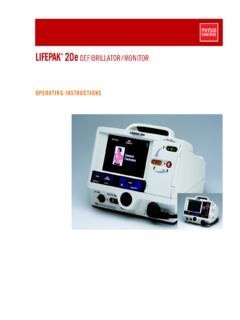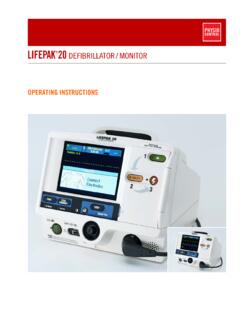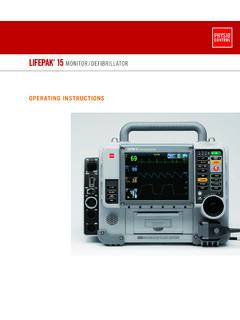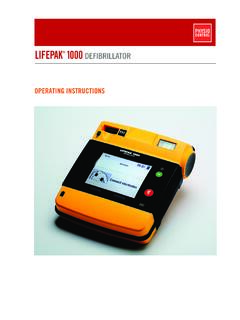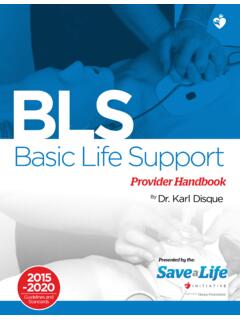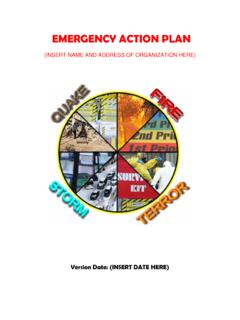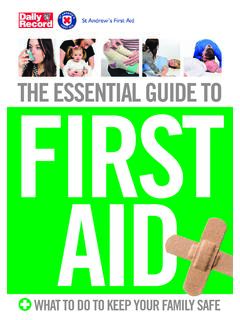Transcription of OPERATING INSTRUCTIONS - Stryker Emergency Care
1 +LIFEPAK CR PlusDEFIBRILLATORLIFEPAK EXPRESS DEFIBRILLATOROPERATING INSTRUCTIONSLIFEPAK CRPlus defibrillator LIFEPAK EXPRESS defibrillator OPERATING INSTRUCTIONSR esponsibility for InformationIt is the responsibility of our customers to ensure that the appropriate person(s) who may use this defibrillator have access to the information in this manual, including general safety information provided in Section OnlyDevice TrackingThe Food and Drug Administration requires defibrillator manufacturers and distributors to track the location of their defibrillators.
2 If the device is located somewhere other than the shipping address or the device has been sold, donated, lost, stolen, exported, destroyed, permanently retired from use, or if the device was not obtained directly from Physio-Control, please do one of the following: register the device at , call the device tracking coordinator at , or use one of the postage-paid address change cards located in the back of this manual to update this vital tracking HistoryThese OPERATING INSTRUCTIONS describe the LIFEPAK CR Plus and LIFEPAK EXPRESS defibrillators with software Version or later.
3 !USA!USALIFEPAK, LIFEPAK CR, LIFEPAK EXPRESS, and QUIK-COMBO are registered trademarks of Physio-Control, Inc. ADAPTIV, CODE-STAT, CHARGE-PAK, QUIK-PAK, and Shock Advisory System are trademarks of Physio-Control, Inc. IrDA is a registered trademark of Infrared Data Association. Specifications are subject to change without notice. 2009 Physio-Control, Inc. All rights 3201686-011 Publication Date: 1/2009 LIFEPAK CR Plus and LIFEPAK EXPRESS defibrillator OPERATING Instructionsiii 2009 Physio-Control, OF CONTENTS11 IntroductionAbout Automatic external Defibrillators.
4 1-2 Indications for 1-2 Contraindications .. 1-2 Why the Need for Defibrillators .. 1-2 Terminology .. 1-3 Text Conventions .. 1-4 Safety Information .. 1-4 Safety Terms .. 1-4 General Warnings and Cautions ..1-5 Symbols .. 1-7 About the LIFEPAK CR Plus and LIFEPAK EXPRESS Defibrillators .. 1-9 Capabilities and 1-102 Getting StartedUnpacking and Inspecting Your LIFEPAK CR Plus or LIFEPAK EXPRESS defibrillator .. 2-2 Where to Locate Your LIFEPAK CR Plus or LIFEPAK EXPRESS defibrillator .. 2-3 Controls, Indicators, and Labels.
5 2-4 Outside Controls, Indicators, and Labels .. 2-4 Inside 2-53 Using the DefibrillatorWarnings and Cautions .. 3-2 Responding to a Sudden Cardiac Arrest Emergency .. 3-2 Basic Steps for Using the LIFEPAK CR Plus or LIFEPAK EXPRESS 3-3 What to Do After Emergency Medical Personnel 3-5 What to Do After Using Your defibrillator .. 3-5 Voice INSTRUCTIONS and Tones .. 3-5 Troubleshooting .. 3-6ivLIFEPAK CR Plus and LIFEPAK EXPRESS defibrillator OPERATING Instructions4 Data StorageOverview of Data Storage .. 4-2 Data Stored by Your defibrillator .
6 4-2 Test and Service Data .. 4-2 Event and Test 4-35 Caring for Your DefibrillatorMaintaining a State of Readiness .. 5-2 Storing Your defibrillator .. 5-2 Cleaning Your defibrillator .. 5-2 Replacing the CHARGE-PAK Battery Charger and the QUIK-PAK Electrode Packet .. 5-4 Replacing the CHARGE-PAK Battery Charger .. 5-5 Replacing the QUIK-PAK Electrode 5-7 Obtaining Authorized Service .. 5-8 Recycling Information .. 5-8 Recycling Assistance .. 5-8 Recycling of Disposable Electrodes .. 5-8 Supplies, Accessories, and Training Tools.
7 5-8 Warranty Information .. 5-86 defibrillator OPERATING SettingsOperating Settings and Setup Configuration .. 6-2A SpecificationsB Shock Advisory SystemC User s ChecklistD Electromagnetic Compatibility GuidanceIndexLIFEPAK CR Plus and LIFEPAK EXPRESS defibrillator OPERATING Instructions1-1 2009 Physio-Control, IntroductionINTRODUCTION1 This section provides background information about defibrillation and includes an overview of LIFEPAK CR Plus and LIFEPAK EXPRESS defibrillator Automatic external Defibrillatorspage 1-2 Safety Information1-4 Symbols1-7 About the LIFEPAK CR Plus and LIFEPAK EXPRESS Defibrillators1-91-2 LIFEPAK CR Plus and LIFEPAK EXPRESS defibrillator OPERATING InstructionsIntroductionABOUT AUTOMATIC external DEFIBRILLATORSThe LIFEPAK CR Plus and LIFEPAK EXPRESS defibrillators are automated external
8 Defibrillators (AEDs). For many years, defibrillators have been used only by medical professionals to treat victims in sudden cardiac arrest (SCA). Today, the ability of defibrillators to save lives is so widely recognized that people once trained to do only cardiopulmonary resuscitation (CPR) can now use electrode pads are applied to the victim s chest, the defibrillator analyzes the victim s heart rhythm. If a shockable rhythm is detected, the defibrillator will either deliver an intense pulse of electricity (shock) to the heart muscle (fully automatic model) or direct the responder to deliver the shock (semiautomatic model).
9 The defibrillator delivers shocks through the electrode pads on the victim s this pulse of electricity is delivered, it is called defibrillation. Defibrillation is recognized for treating life-threatening heart beat irregularities, such as ventricular fibrillation, that cause LIFEPAK CR Plus and LIFEPAK EXPRESS defibrillators are designed specifically for infrequent use and for use by people whose only training is in CPR and in using for UseThe LIFEPAK CR Plus and LIFEPAK EXPRESS defibrillators are indicated for use on patients in cardiac arrest.
10 The patient must be unresponsive (unconscious), not breathing normally, and showing no signs of circulation (for example, no pulse, no coughing, or no movement). With Infant/Child Reduced Energy Defibrillation Electrodes, the LIFEPAK CR Plus and LIFEPAK EXPRESS defibrillators may be used on children who are up to 8 years old or who weigh up to 25 kg (55 lb).ContraindicationsNone the Need for DefibrillatorsThe American Heart Association estimates that, in the USA alone, at least 250,000 people die each year of cardiac arrest.
